Wisconsin Biologist Discovers the 'Holy Grail' of Rare Plants
Have you ever seen a green violet? Neither have most people – with the exception of one conversation biologist from Wisconsin...
Wisconsin Department of Natural Resources

A Wisconsin Department of Natural Resources (DNR) conservation biologist has found the “holy grail” of a rare plant in Wisconsin: A green violet long thought gone from the state, but growing by the hundreds in a State Natural Area (SNA) in west central Wisconsin.
The species (Hybanthus concolor) was last documented in Wisconsin in 1958 when it was collected from a site in Grant County. That site was severely impacted by grazing and the species was thought to no longer grow in the state.“It was pretty exciting,” said DNR Conservation Biologist Ryan O’Connor. “It really drives home several things, including that there are still important things to discover on State Natural Areas and that our SNAs are vital to the conservation of plants and animals, some of which are found nowhere else in the state.”
This isn’t the first rare plant finding within Wisconsin’s State Natural Areas – 75% of wildlife species listed in Wisconsin as threatened or endangered, and 90% of state-listed plants are supported on State Natural Areas. These sites, owned both by the DNR and more than 50 partners, represent Wisconsin’s best native forests, wetlands, prairies and geological and archaeological sites. Their primary purpose is to maintain this natural heritage for future generations.
O’Connor’s discovery also underscores the importance of having experts conduct “biotic inventory surveys” to document the different rare species on state-owned lands and assess how the natural community they are part of is faring.
Green violets are native to the eastern United States. Wisconsin is at the very northern edge of the green violet range. Across its range, green violet is limited to rich mesic forests on limestone soil. Many of these sites have been lost to logging, grazing and invasion by weeds like garlic mustard and honeysuckle.
Learn more about the rare find, and other preservation efforts, at dnr.wisconsin.gov.


